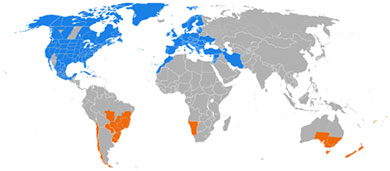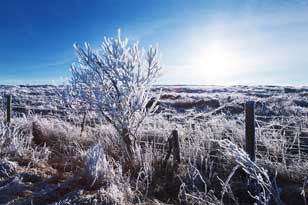Daylight Saving Time
And Why the Big Hassle About It?
Updated: 5th August 2012
DST - Introduction
During summer when the sun is up early but the citizens are in sleep is a waste of sunlight. Daylight saving time (DST), helps with this issue by adjusting the clocks one hour forward during the summer months. This method makes days feel longer since the first light hour in the morning when people are often in sleep is moved to the late afternoon. Other terms for daylight saving time are daylight savings, daylight savings time and summer time, while officially it is daylight saving time.
The principle idea of using sunlight instead of artificial light was first satirically introduced by Benjamin Franklin in 1784 in his letter to the editor of the Journal of Paris where he argued that a significant amount of tallow and wax could be saved by going to bed early and to wake up at sunrise. However, the first approach towards the implementation of DST was in 1895 by George Vernon Hudson, who suggested it in New Zealand.[1] Shortly afterwards in 1907 William Willet introduced DST in Britain, but it wasn't until 1916 that DST was first time trialed.[2]
DST was used first time during the World War I and World War II to save energy. During those days the main energy usage was incandescent lighting. However, today the patterns of energy usage have changed dramatically. Instead of lighting, the peak energy consumption is more weather-related heating or cooling.[3]
Ever since the introduction of daylight saving time there has been a wide range of opinions about it. A number of businesses are benefitting from DST, one example is golf clubs another is sporting goods retailers. Sport enthusiasts are taking advantage of the longer days and join sport clubs or invest in sport gear. Convenience stores are also benefiting from DST, since potential customers will spend longer time outdoors after work for example for a picnic. In retail DST extends the midday sales peak and boosts shopping in the evening. The businesses that DST effects negatively are television networks because potential customers prefer staying out later in the evenings missing the prime time broadcasts.[4] For the same reason movie theaters are losing customers during DST.
Daylight saving time does create some challenges. It complicates timekeeping, and can disrupt travel, meetings, recordkeeping, medical devices, heavy equipment and sleep patterns. In IT industry the time changes can be automated, but they are still error-prone, especially when DST dates are altered.[5]
People notice mostly the recreational benefits of DST, and are often unaware of the other effects. DST is popular, and yet the evidence for the basic premise on which it was introduced, energy savings, appears to be misunderstood or forgotten.[6]
History of Daylight Saving Time
An anonymous satiric article by Benjamin Franklin was published in 1784 about how many candles are wasted in the evenings during summer by staying up late and sleeping late in the morning instead of going to bed earlier and waking up at sun rise.[7] However, George Vernon Hudson was the first to propose DST. In 1895 he presented a paper to the Wellington Philosophical Society in New Zealand advocating seasonal time adjustment. In 1927 it was trialed successfully in New Zealand.[1]
Daylight Saving Time was introduced in Britain by William Willet in 1907. He was a keen horse-rider, who was incensed at the 'waste' of useful daylight first thing in the morning, during summer. Even though the sun had been up for hours during his rides through the local woods in Chislehurst and Petts Wood, people were still asleep.[2]
Willett published a pamphlet called “The Waste of Daylight” In 1907, outlining plans to encourage people out of bed earlier in summer by changing the time on the nation’s clocks. He spent the rest of his life fighting to get his time-shifting scheme accepted. He died in 1915 with the Government still refusing to back DST. But in the following year, Germany introduced the system and Britain followed shortly afterwards.[2]
Brandon, Manitoba in Canada was the first location in the world to use daylight saving time. It was applied there on 17th April 1916. But the first countries to use DST was Germany with its World War I allies to decrease the wartime coal consumption. Germany shifted its clocks the first time on 30th April 1916, and Britain followed in May 1916. Most of the European countries also adopted DST in the same year, but Russia waited till the next year and United States adopted DST in 1918.
Why We Use Daylight Saving Time?
The potential of DST to reduce electric power usage was clear since the World War I and World War II. On those days the main use of electricity was for incandescent lighting. The shift of clocks one hour forward resulting an hour more sunlight in the evenings or in other words one hour less electric light usage in the evenings reduces the total energy consumption and possible peak demand.[3]
Our patterns of energy use have changed considerably since World War I and II, so that it is not a foregone conclusion that significant energy savings will result from extended DST today. Incandescent lighting is no longer the primary use of electricity and its use does not always peak after sunset. Peaks are now more likely to depend on weather-related heating and cooling and vary from one region to another.[3]
The Department of Transportation (DOT) conducted a study on the effects of the extended DST on energy consumption. The report released in 1975 estimated that year-round DST resulted in approximately 1% reduction in energy consumption.[3]
According to the DOT report from 1975, daylight saving time prevents crime, since people get home from work and school earlier and complete more errands and chores in daylight. DST seems to reduce people's exposure to various crimes, which are more common in darkness than in daylight.[3]
When a nation is on daylight saving time there is one hour more of darkness in the morning and one hour less in the evening. This makes possible for more people to travel home from work and school in daylight, which is much safer than in darkness. The DOT assumed that there should be an increase in morning fatal accidents and a decrease in evening fatal accidents. Because there are more fatal accidents in the evening, DST should produce a net decrease in the total number of fatal accidents.[3]
Various studies have verified the effects of daylight saving time on traffic, health, leisure, and safety. However, the main reason for introducing and extending DST was energy savings, particularly for electric lighting. Several studies state to have demonstrated the expected reductions in overall electricity use (0.5 to 2%), largely as a result of residential lighting reduction. On the other hand, there are just as many studies that suggest no effect, or that the data is too unreliable to draw a conclusion.[6]
Comparison of different studies of the benefits of daylight saving time is hindered by many factors, including a lack of consistency of methods, assumptions, building types, climates, and locations. Furthermore, the reliability of the data from which conclusions have been drawn has been called into question. Studies that have looked at real system-wide energy use before and after clock adjustments have experienced great difficulty in isolating the effect of DST from other day-today variations.[6]
Countries Following DST

Daylight saving time countries (Oct 2011 update).
Northern hemisphere summer

Southern hemisphere summer
In the equator DST has no effect since the number of sunlight hours per day stay constant year-round. However, in areas where the length of the sunlight per day changes noticeable throughout the year like in New York,[8] DST may save energy. Furthermore, in areas closer to north pole and south pole where during winter are only a few hours of sunlight, and plenty during summer, DST does not make a big difference. For example during summer in a location close to north pole where sun is up 24 hours a day, applying DST seems useless in means to save energy.
The countries following DST vary according to continent. Most of the areas in Europe and North America[9] follow DST, while Asia and Africa stay more on standard time. In Oceania, Samoa and New Zealand follow DST while in Australia only the southern part of the country follows it. South America is rather mixed, most of the countries are not following DST, but the ones which do are southern part of Brazil, Chile, Paraguay and Uruguay.[10][11]
References:
[1]
Gibbs, G.
Hudson, George Vernon 1867–1946 [online] The Encyclopedia of New Zealand. Available from: http://www.teara.govt.nz/en/biographies/3h42/1 [Accessed 3
Feb 2012]
[2]
Spring Forward: 100 years of British Summer Time [online] Royal Museums Greenwich. Available from: http://www.rmg.co.uk/explore/astronomy-and-time/time-facts/spring-forward-100-years-of-british-summer-time [Accessed 3
Feb 2012]
[3]
Energy Conservation Potential Of Extended And Double Daylight Saving Time. 2001. [online] Committee on Space Science and Technology. Available from: http://commdocs.house.gov/committees/science/hsy73325.000/hsy73325_0.HTM [Accessed 3
Feb 2012]
[4]
Duttge W., 2008.
Will daylight saving time boost profits? [online] msnbc.com. Available from: http://www.msnbc.msn.com/id/23523332/ns/business-us_business/t/will-daylight-saving-time-boost-profits/#.T9ZGb8UbDct [Accessed 31
Jan 2012]
[5]
Tong S., Williams J., 2007.
Are You Prepared for Daylight Saving Time 2007?
[online] IEEE Xplore Digital Library. Available from:
http://ieeexplore.ieee.org/xpl/articleDetails.jsp?reload=true&arnumber=4079501
[Accessed 3 Feb 2012]
[6]
Aries M.B.C., Newsham G.R., 2008.
Effect of daylight saving time on lighting energy use: a literature review
[online] Institute for Research in Construction. Available from:
http://www.nrc-cnrc.gc.ca/obj/irc/doc/pubs/nrcc49212/nrcc49212.pdf
[Accessed 3 Feb 2012]
[7]
Franklin B., 1784.
To the Authors of the Journal of Paris.
[online] Available from:
http://www.webexhibits.org/daylightsaving/franklin3.html
[Accessed 3 Feb 2012]
[8]
Local current time in New York City, New York, United States
[online] Time-time.net. Available from:
http://time-time.net/time/new-york-new-york-usa.php [Accessed 3
Feb 2012]
[9]
Daylight Saving Time
[online] Infoplease.com. Available from:
http://www.infoplease.com/spot/daylight1.html [Accessed 31 Jan 2012]
[10]
Countries and territories operating Daylight Saving Time
[online] Worldtimezone.com. Available from:
http://www.worldtimezone.com/daylight.html [Accessed 31 Jan 2012]
[11]
Daylight Saving Time Around the World 2012
[online] Timeanddate.com. Available from:
http://www.timeanddate.com/time/dst/2012.html [Accessed 31 Jan 2012]


